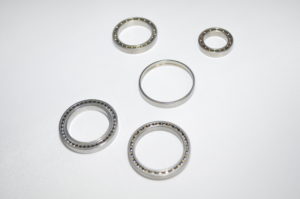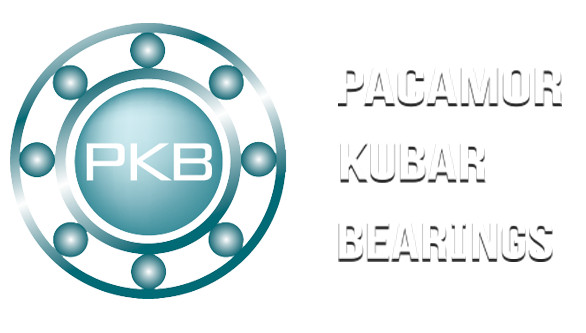How-To Guide: Proper Lubrication of Miniature & Instrument Ball Bearings
 Bearing lubrication is an essential element of bearing selection. Proper lubricant can reduce friction, prevent bearing wear, protect bearing surfaces from corrosion, and carry away excess heat from bearing operation. Pacamor Kubar Bearings(PKB), selects only bearing approved and tested oils and greases for our wide variety of lubricant options. Bearings operate on a very thin film of lubricant which must be maintained, or replaced, to ensure that maximum bearing life is achieved.
Bearing lubrication is an essential element of bearing selection. Proper lubricant can reduce friction, prevent bearing wear, protect bearing surfaces from corrosion, and carry away excess heat from bearing operation. Pacamor Kubar Bearings(PKB), selects only bearing approved and tested oils and greases for our wide variety of lubricant options. Bearings operate on a very thin film of lubricant which must be maintained, or replaced, to ensure that maximum bearing life is achieved.
Proper selection, application, and maintenance are vital in maximizing bearing life. Using the proper lubrication in the bearing will reduce friction and wear. This is achieved by creating a hydrodynamic film of appropriate thickness and strength to support the load while separating the balls from the raceway.
How Does Lubrication Impact Bearing Life?
Bearing lubrication prevents against metal to metal contact. It also minimizes retainer wear by reducing friction. Proper lubricant will conduct heat away from the bearing. Operational conditions such as temperature, loads, speed, torque, and environment determine the lube appropriate for the application.
Should I choose Oil, Grease, or Dry-Film Lubricant for My Application?

Dicronite-coated bearings*
Oils are used where low bearing friction torque is a primary concern. Grease may provide longer operating life and resist lubricant loss due to centrifugal forces at higher speeds. Dry-film lubricant, such as Dicronite, is often appropriate for vacuum environments or other conditions where wet lube is not an option. Pacamor Kubar Bearings(PKB) offers bearing lubrication in grease form, oil lubricants, and solid dry film lubricants.
*You can find more info. on Dicronite, here.
What is Wettability and Why is it Important?
Wettability is the ability of a liquid to maintain contact with a solid surface. A bearing that is contaminated with two different surface treatments (intentional or unintentional contamination by other lubricants, soaps, detergents, hand cream, food products, etc), could result in a non-wettable condition on the raceway. In simplest terms, think about driving a car on the highway and the weather turns stormy. Rain pours onto the highway, mixing with the gas, oil, rubber, and other debris that was already coating the road. The road becomes very slippery in some places and not as slippery in others. The automobile’s tires slip and then gain traction and then slip again, on the differently lubricated surfaces of the road.
When Should Bearings be Re-Lubed?
Bearings should be re-lubed at the recommendation of the bearing manufacturer, when the bearings have been subjected to temperature conditions outside of the recommended temperature range, if the bearings have become contaminated, if the original packaging has become damaged, if you’re unsure of the lubricant’s expiration date, if there is any question about the quality, condition, or type of lubricant in the bearings, or if the bearing lubrication appears to have separated, discolored, or otherwise changed appearance.
Can I Wash out the Lubrication and Install New Lube?
Many 440C Stainless Steel Bearings that are used in Aerospace, Medical, and other applications can be cleaned and re-lubricated, in proper clean room conditions and by properly trained personnel. Improper handling can result in cross contamination, problems with wettability on balls & bearing races, or ball & raceway damage, as well as broken, cracked, lost or otherwise unusable retainers, seals, shields, or wires. PKB provides bearing wash and re-lube services, for many aerospace OEM’s and authorized re-sellers, in our factory clean room.
PKB maintains an extensive inventory of popular lubricant options. Dry-film lubricants are also available upon request.
For further assistance with bearing selection and design, please feel free to contact our engineering team.
See our Bearing Installation Guide & Bearing Handling Practices pages for more information about proper handling installation of the PKB bearing into your device. Be sure to visit our Shaft and Housing Fits page for detailed information about this topic.
Other Recent Blog Topics:
- See our Shaft and Housing Fits page for a detailed chart and more information about this topic.
- See our Bearing Handling Practices blog, for more information about proper handling installation of PKB bearing, for improved bearing performance and life.
- See our Bearing Installation Guide page for more information about proper handling installation of PKB bearings into your device.
For further assistance with bearing selection and design, please feel free to contact us at sales@pacamor.com
Pacamor Kubar Bearings manufactures DFARS approved FAA TSO-C149 Aircraft Bearings in our ISO 9001:2015 certified factory in Troy, NY.






